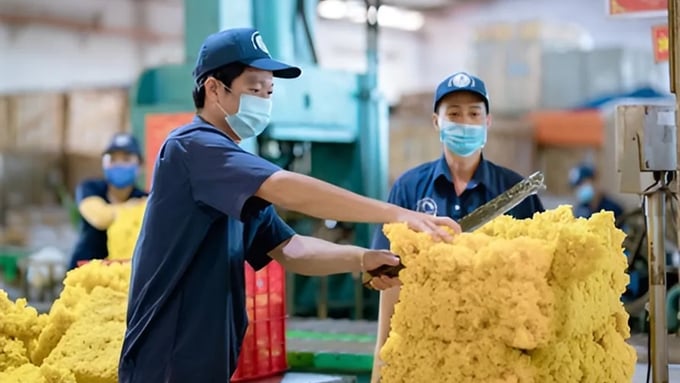November 22, 2025 | 16:14 GMT +7
November 22, 2025 | 16:14 GMT +7
Hotline: 0913.378.918
November 22, 2025 | 16:14 GMT +7
Hotline: 0913.378.918

Global rubber consumption currently exceeds production.
According to the Agency of Foreign Trade under the Ministry of Industry and Trade, rubber prices are experiencing mixed fluctuations across key Asian markets; however, the overall trend is more sharply downward. Market sentiment is currently dominated by the lowered demand from China following the Lunar New Year holiday and traders' concerns over trade tensions between the United States and China, after China imposed retaliatory tariffs on U.S. goods.
The Chinese Ministry of Finance announced that imports of U.S. coal and liquefied natural gas (LNG) will be subject to a 15% tariff, while crude oil, agricultural equipment, and select imported automobile items will face a 10% tariff. Additionally, China has declared its intention to file a lawsuit against the U.S. with the World Trade Organization (WTO) and implement countermeasures accordingly.
Chinese tire manufacturers resumed operations after the Lunar New Year break in early February, albeit at a limited production capacity. The operating rate of all-steel tire factories in China was recorded at over 13%, while that of semi-steel tire manufacturers was nearly 13%.
However, the decline in rubber prices has been restricted due to market support for adverse weather conditions in Thailand, the world's largest rubber exporter. Recent heavy rainfall in southern Thailand has disrupted latex harvesting ahead of the leaf-shedding season, which spans from February to May, when rubber tree yields are typically lower.
Amid the general price decline in Asian markets, Vietnam's rubber export prices slightly decreased in January compared to December 2024 but remained at favorable levels. The Agency of Foreign Trade reported that in January, Vietnam’s average rubber export price reached 1,859 USD per ton, marking a 32% increase from January 2024. Despite a 24% drop in export volume compared to the corresponding period in 2024 due to the Lunar New Year holiday, export revenue saw a slight increase of 0.6%, supported by high rubber prices.
Rubber prices are expected to remain high for the foreseeable future due to a seasonal supply shortage. Prices are also supported by a long-term global supply-demand imbalance.
In a recent report, the Association of Natural Rubber Producing Countries (ANRPC) estimated that global rubber consumption exceeded production by 1.16 million tons in 2024. ANRPC also predicts that the global rubber supply shortage has the potential to persist until 2028, leading to an annual shortfall of 600,000 to 800,000 tons.
In recent years, rubber plantation areas in major Southeast Asian producing countries such as Thailand and Indonesia have gradually declined as farmers transitioned from rubber to more profitable crops.
China remained Vietnam's largest rubber export market in January 2025, accounting for 79% of the total export volume and 78% of total revenue. Vietnam exported 126,000 tons of rubber to China, for a total revenue of 233 million USD. This is a decrease of 24.7% in volume and an increase of 0.1% in revenue compared to the corresponding period in 2024. Furthermore, the average export price to this market reached 1,846 USD per ton, marking a 33% increase.
Translated by Nguyen Hai Long
/2025/11/21/4309-2-153400_128.jpg)
(VAN) Green and low-emission rice is paving the way for Vietnamese rice to enter high-end markets, marking the beginning of a transformation journey toward greening and elevating the national rice brand.

(VAN) ‘Right to Win’ outlines a national action plan that shapes a new vision for Viet Nam’s agriculture in an era of renewal and global integration.

(VAN) Lam Dong’s farmed sturgeon output this year is expected to reach 2,300 tons, worth VND 450 billion, affirming the brand’s position on the market.

(VAN) A surge in Ukrainian egg exports, largely driven by soaring sales to the UK over the last few years, has notably pushed up egg prices on the domestic market.

(VAN) The price of Arabica Catimor coffee in Quang Tri is currently at VND 25,000–27,000/kg (fresh cherries), the highest level ever recorded

(VAN) 'From the coffee story, we can think deeper and further about the crop production sector - from development orientations and value-chain organization to international integration,' assessed Dr Le Quoc Doanh.
/2025/11/18/2431-0-161627_248.jpg)
(VAN) Viet Nam accounts for 43% of the world's export volume of Robusta coffee. However, the Vietnamese Robusta coffee brand has yet to gain broad recognition on the global market.